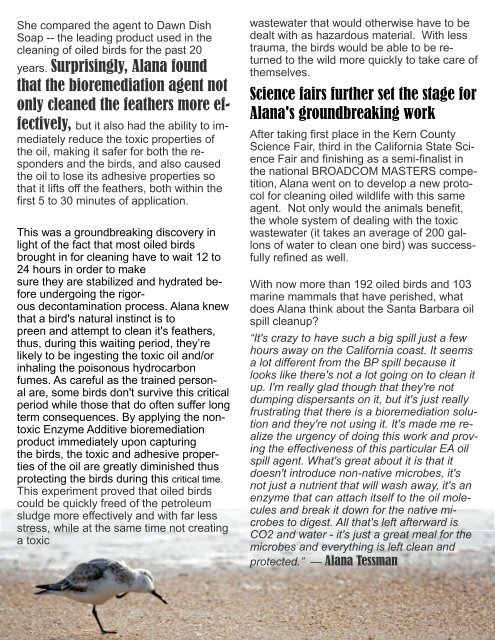E The Magazine For Today's Female Executive August 2018 issue
The theme for this month's issue of E The Magazine for Today's Female Executive is "Jump out of The Box!" Featuring Innovators and Social Change Agents. We have awesome book reviews, coaching series,
The theme for this month's issue of E The Magazine for Today's Female Executive is "Jump out of The Box!" Featuring Innovators and Social Change Agents. We have awesome book reviews, coaching series,
You also want an ePaper? Increase the reach of your titles
YUMPU automatically turns print PDFs into web optimized ePapers that Google loves.
She compared the agent to Dawn Dish<br />
Soap -- the leading product used in the<br />
cleaning of oiled birds for the past 20<br />
years. Surprisingly, Alana found<br />
that the bioremediation agent not<br />
only cleaned the feathers more effectively,<br />
but it also had the ability to immediately<br />
reduce the toxic properties of<br />
the oil, making it safer for both the responders<br />
and the birds, and also caused<br />
the oil to lose its adhesive properties so<br />
that it lifts off the feathers, both within the<br />
first 5 to 30 minutes of application.<br />
This was a groundbreaking discovery in<br />
light of the fact that most oiled birds<br />
brought in for cleaning have to wait 12 to<br />
24 hours in order to make<br />
sure they are stabilized and hydrated before<br />
undergoing the rigorous<br />
decontamination process. Alana knew<br />
that a bird's natural instinct is to<br />
preen and attempt to clean it's feathers,<br />
thus, during this waiting period, they’re<br />
likely to be ingesting the toxic oil and/or<br />
inhaling the poisonous hydrocarbon<br />
fumes. As careful as the trained personal<br />
are, some birds don't survive this critical<br />
period while those that do often suffer long<br />
term consequences. By applying the nontoxic<br />
Enzyme Additive bioremediation<br />
product immediately upon capturing<br />
the birds, the toxic and adhesive properties<br />
of the oil are greatly diminished thus<br />
protecting the birds during this critical time.<br />
This experiment proved that oiled birds<br />
could be quickly freed of the petroleum<br />
sludge more effectively and with far less<br />
stress, while at the same time not creating<br />
a toxic<br />
wastewater that would otherwise have to be<br />
dealt with as hazardous material. With less<br />
trauma, the birds would be able to be returned<br />
to the wild more quickly to take care of<br />
themselves.<br />
Science fairs further set the stage for<br />
Alana's groundbreaking work<br />
After taking first place in the Kern County<br />
Science Fair, third in the California State Science<br />
Fair and finishing as a semi-finalist in<br />
the national BROADCOM MASTERS competition,<br />
Alana went on to develop a new protocol<br />
for cleaning oiled wildlife with this same<br />
agent. Not only would the animals benefit,<br />
the whole system of dealing with the toxic<br />
wastewater (it takes an average of 200 gallons<br />
of water to clean one bird) was successfully<br />
refined as well.<br />
With now more than 192 oiled birds and 103<br />
marine mammals that have perished, what<br />
does Alana think about the Santa Barbara oil<br />
spill cleanup?<br />
“It's crazy to have such a big spill just a few<br />
hours away on the California coast. It seems<br />
a lot different from the BP spill because it<br />
looks like there's not a lot going on to clean it<br />
up. I'm really glad though that they're not<br />
dumping dispersants on it, but it's just really<br />
frustrating that there is a bioremediation solution<br />
and they're not using it. It's made me realize<br />
the urgency of doing this work and proving<br />
the effectiveness of this particular EA oil<br />
spill agent. What's great about it is that it<br />
doesn't introduce non-native microbes, it's<br />
not just a nutrient that will wash away, it's an<br />
enzyme that can attach itself to the oil molecules<br />
and break it down for the native microbes<br />
to digest. All that's left afterward is<br />
CO2 and water - it's just a great meal for the<br />
microbes and everything is left clean and<br />
protected.” — Alana Tessman<br />
Page 53 E <strong>The</strong> <strong>Magazine</strong> for Today’s <strong>Female</strong> <strong>Executive</strong><br />
Subscription link ETMMedia.net




